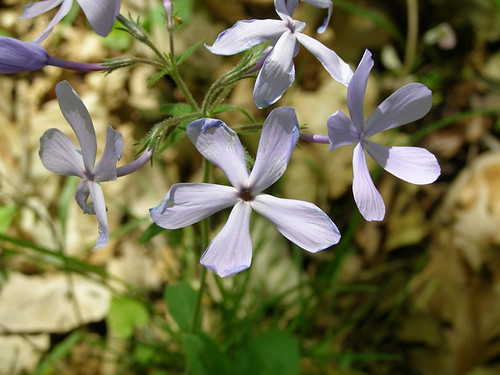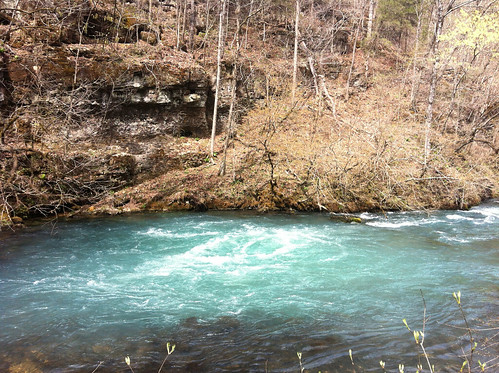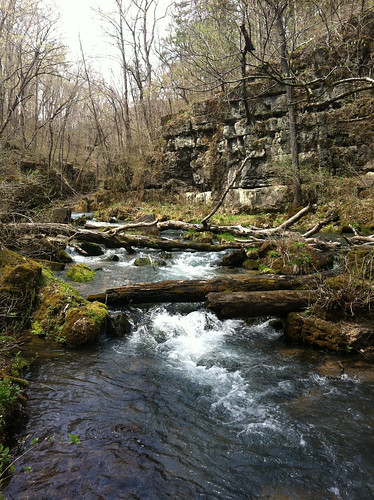
Hiking along the peaceful Greer Spring Trail in the Mark Twain National Forest the pathway is decorated with abundant wildflowers in bloom—vibrant yellow trout lily, Jacob’s ladder and white harbinger of spring. Look up and you may see Indian pipe, bird’s-foot violet, and firepink scattered along the ridgetops.
The reward for your near-mile-long hike is a specular view of Greer Spring, Missouri’s second largest spring. Through the mist you will find beautiful smooth waters cascading over rocks and plentiful ferns and mosses. Bishop’s cap, Ebony spleenwort, and wild columbine are scattered along the dolomite cliffs that surround the spring. Following the spring’s path you will find horned pondweed, elodea, and waterthread pondweed.
The best part is that you can view this splendor right now, as peak wildflower viewing in this area is March through mid-June.
Beyond their aesthetic beauty, wildflowers support entire ecosystems for butterflies, birds and small animals by providing a source of seeds, nectar and pollen for their food supply and life support systems. Wildflowers and native plants also help conserve water, reduce mowing costs, protect the soil from erosion and provide habitat for wildlife.
Many wildflowers are endangered by non-indigenous species that crowd them out of their natural habitat. These invasive plants tend to grow aggressively and compete for resources, often causing great harm and even destruction to native plants. You can help protect them by volunteering for an invasive plant removal project on a national forest or grassland in your area.
In celebration of National Wildflower Week, May 2-8, 2016, we invite you to visit these lovely gems in our Eastern Region. A field of wildflowers is one of the most beautiful scenes you can experience in nature!

Use the peak wildflower viewing times below to help plan your trip!
April – early May Wildcat Hollow Trail (Wayne National Forest, Ohio): White diamonds dot the Athens Ranger District’s most popular hiking trail.
April –early May Prairie Creek Woods (Midewin National Tallgrass Prairie, Illinois): Woodland wildflowers are in full bloom along the trail, which opens after 1:00 p.m. daily).
Late April - June Grand Island National Recreation Area (Hiawatha National ForestMichigan): This area offers a little bit of everything – from forests to shoreline cliffs to beaches to the restored “old farm field,” which features nearly 225,000 native wildflowers.
Late May – early June Black River Harbor Area (Ottawa National Forest, Michigan): Catch lovely displays of spring wildflowers, including two-leaf toothworts and trout lily, as well as waterfalls and sandstone rock formations.
May –July Dolly Sods (Monongahela National Forest, West Virginia): The heath barrens, mountain laurel, and rhododendron blueberries provide a fantastic floral display.
Late June-early July Longhouse National Scenic Byway-State Route 59 (Allegheny National Forest, Pennsylvania): Take a scenic drive along State Route 59 to catch the state flower Mt. Laurel in full bloom. Please pull over in a safe spot before stopping to take photos.
Late June-July Mount Washington (White Mountain National Forest, New Hampshire): Rising above all other peaks in the northeast, Mt. Washington is a crown jewel of the forest. The landscape features an amazing array of wildflowers in bloom contrasted against the backdrop of green forests and gray rocks.
Late June – early August Pennington Bog (Chippewa National Forest, Minnesota): See wildflowers such as round-leaved orchids and showy lady slippers at their peak.
Late June – August Grand Island National Recreation Area (Hiawatha National Forest, Michigan): This area offers a little bit of everything – from forests to shoreline cliffs to beaches to the restored “old farm field,” which features nearly 225,000 native wildflowers.
July Catwillow Monarch Area (Chequamegon-Nicolet National Forest, Wisconsin): Be welcomed by fluttering butterflies when common milkweed is in full bloom.
July – August Chittendon Pollinator Gardens (Huron-Manistee National Forest, Michigan): Explore the area’s 26 species of native grasses and wildflowers.
More travel and planning ideas are available from the Forest Service’s Celebrating Wildflowers website, which includes a searchable wildflower viewing map.
As always, we ask that you enjoy the experience and take pictures, but do not remove vegetation, including wildflowers, from public lands. Almost all wildflowers are fragile and many wilt and perish if disturbed.



